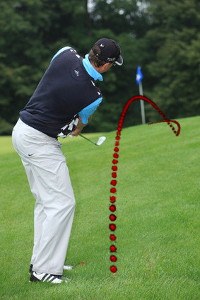
When playing from thick rough, it's generally wise to take the most lofted club possible based on your distance to the target. It's also difficult – and inadvisable -- to play a low, running shot from thick grass.
The exception to both rules is when you're relatively close to the green and have room to run the ball onto the surface.
For example, let's say you've got 120 yards to the flag, with no hazards between you and the front of the green. While you could try to muscle the ball to fly the full distance, you risk a big pull if the grass grabs the hosel and turns the clubhead over. Instead, take one or two clubs extra (8- or 9-iron instead of pitching wedge) and pick out a spot short of the green where you want to land the ball.

Then execute the shot by:
- Gripping down a couple of inches and squaring the clubface to your target.
- Placing the ball in the center of your stance and aiming slightly right of your target; the ball will often come out left when hit from heavy rough.
- Making a three-quarters swing that accelerates through impact.
The ball will shoot out low, hit the ground running and roll onto (or at least near) the green. This method makes it easier to control the shot, removing the variables that come into play with a full swing from thick grass.
In almost every situation, you would rather find your ball resting on the fairway than sitting in the rough.

The rough is not an attractive place to be because it causes you to lose a measure of control over your shots. Since the ball is not going to spin as much when played from the rough as compared to the fairway, it will be harder to manage your distance control in this scenario. By keeping your ball on the short grass as often as possible, you'll gain control and your game will improve overall.
With all of that said, you are going to inevitably wind up in the rough from time to time. This is a hard game, and no golfer is perfect. In fact, even if you were somehow a perfect golfer, your ball would still find the rough on occasion as a result of bad luck. Whether it is a gust of wind or a bad bounce, there are some things in golf that are out of your control. So, even though you'd rather be in the fairway, you need to know how to play the ball properly from the rough when this situation does come up.
In this article, we are going to be talking about a specific type of shot that is played from the rough. This is an approach shot from short distance – less than 100-yards or so. When you find yourself in this spot, what do you do? We are going to make the argument that the best way to conquer this type of shot is to play a run up shot, rather than trying to fly the ball all the way to the target. The run up shot will not work in every situation, of course, but it is a nice option when you have enough room available to make it work.
The modern game of golf is played largely through the air, with very few golfers opting to play low, running shots up toward the target. The equipment we use today makes that possible, so there is nothing wrong with air-based attack. However, you would be wise to add at least one or two low shots to your playbook. When hitting the ball high is not an attractive choice for one reason or another, it is nice to know that you can play the ball down along the ground to achieve solid results.
All of the content below is based on a right-handed golfer. If you happen to play left-handed, please take a moment to reverse the directions as necessary.
The Challenges

At first, you might not think that a short approach shot from the rough would be all that difficult. After all, most golf courses don't keep their rough cut very long these days, meaning you'll usually have a decent lie even when you stray from the fairway. It shouldn't be hard to cover the distance you have remaining to the hole, and it shouldn't be hard to get the shot on line.
So, what is the issue? It all comes down to controlling the distance of the shot. You won't be able to predict the distance of this shot as accurately as you would be able to if playing from the fairway. The ball will have very little backspin, which makes it harder to control, and contact may be made slightly high on the face, which will impact the total distance that the ball travels through the air. In the end, this winds up being one of those shots that is much more difficult than it appears at first. When you play a long shot over water, you understand right away that you are in for a challenge – the difficulty of the shot is obvious. With this type of shot, however, it is subtle. There is nothing intimidating about the situation, but it can cost you a stroke or two just the same.
To bring more clarity to this topic, let's look at three specific points that make this a tough shot.
- Finding a landing spot. Right away, you may struggle to pick out a good landing spot for this type of shot. As mentioned above, the ball is not going to have as much spin as it would when coming from the fairway. Therefore, you will need to land the ball in a position which provides it with plenty of room to bounce and roll before it reaches the hole. But do you have enough room available for this kind of shot? How high will you need to hit the ball in order to have it stop in time? In some situations, you'll have plenty of room and it won't be a problem. In other circumstances, however, you'll struggle to pick out the place to have the ball come down.
- Reading the lie. Every lie you draw in the rough is unique. Sometimes the ball will sit down at the bottom of the rough, requiring you to work down through the grass in order to make contact. In other cases, the ball will rest on top of the grass, almost as though it was on a tee. When that happens, the big risk is going too far under the ball, making contact high on the face and leaving the ball well short. These are particularly tricky because you may believe that you have a great lie, since you can see the entire ball at address. Don't fall into this trap. The ball sitting on top of the grass is a dangerous lie in the rough, and you have to pay close attention in order to play a good shot.
- Having the right touch. Most of the time, you won't be making a full swing in this situation. For instance, you might have only 60 yards to your landing spot, and you might be using a club that can carry the ball 80 yards with a full swing. That means you'll need to cut down on your swing in order to hit the ball the right distance. This is a natural part of golf, as you are always going to have to play partial shots as a part of any round. This is tricky out of the rough, however, since you are already having to guess how the ball is going to come out of the grass. Partial shots are much easier from the fairway, where you can rely on a predictable amount of power being transferred to the ball (assuming you make clean contact, of course).
A short approach shot played out of the rough is never going to be easy. Some of these shots will be more difficult than others, but it will always be a challenge to leave the ball close to the hole. If you tend to struggle on these shots when trying to play them up in the air, learning to how to play them along the ground could be a great option.
Basics of a Run Up Shot

As mentioned earlier in the article, the modern game of golf tends to be played through the air. Most golfers don't give a second thought to playing the ball along the ground, since it seems easier to just fly the shot all the way up to the target. This is a huge change from the origins of golf, which saw the game played almost exclusively down along the turf. Of course, modern equipment is responsible for the dramatic shift, as the high spin rate offered by today's golf balls allows you to carry your shots up near the target and stop them quickly after they land.
While it doesn't seem like the trend of playing the ball through the air is going to change anytime soon, it is still worth understanding how to play a run up shot. There will be situations which come up from time to time – such as a short approach shot from the rough – where you may be better served to keep the ball down. You can't expect to pull off such a shot if you haven't practiced it ahead of time. Let's take a quick look at some of the basics you will need to play a successful run up shot.
- Make a soft swing. When you want to keep the ball down, you need to reduce the overall speed of your swing. It is speed that creates spin, and spin is what you are trying to avoid here. Even when playing out of the rough, where spin will be naturally reduced, it is still a good idea to use a soft swing in order to keep the ball down.
- Use less loft. You would probably have been able to figure this point out on your own. When trying to play a run up shot, you should use less loft than you would typically use from a given distance. For example, if you are playing an approach shot out of the rough from 80 yards away, you may normally use a sand wedge for the job. However, if you are going to run the ball up, your club of choice may be a nine iron or pitching wedge – or something with even less loft. The exact club you choose is going to depend on how far you need the ball to run after it lands. Are you going to run the shot almost the entire way, or will you still carry a significant portion of the shot through the air? You'll need to plan out the shot carefully before picking a club that suits your needs.
- Move the ball back in your stance. In most cases, it is a good idea to move the ball back in your stance when you need to hit a low shot. With that said, you don't want to go too far with this point. If you move the ball too far back, your swing is likely to get steep, and you may struggle to make clean contact. Try playing the ball roughly in the middle of your stance, if not an inch or two behind center. This will allow you to produce a low shot without an excessively steep swing.
- Stay still. A run up shot is not one where you need to be using a tremendous amount of effort. In fact, when you are using this shot on a short approach from the rough, it should take very little in the way of power to send the ball up toward the hole. With that in mind, you want to focus on keeping your body as still as possible during the swing. You'll need a bit of a shoulder turn, of course, and you'll have to let your hands work through the hitting area. Other than that, try to keep things relatively calm and quiet, and keep your head still. It's important to make clean contact in order to hit the ball the expected distance as often as possible.
Compared to some of the other shots you will hit on the golf course, a run up shot is actually pretty simple. Playing the ball along the ground is easier, in most cases, than hitting the ball way up into the air. Nevertheless, you need to practice this shot from time to time so you can rely on it under pressure. Hit a few low punch shots during each driving range session and you will gradually gain confidence in this play.
Other Uses: We have been talking about using a run up shot to deal with short approaches out of the rough. That is one circumstance where this shot is useful, of course, but it is not the only time you can run the ball up toward the target. To wrap up this article, let's look at a couple of other situations where playing the ball along the ground is a wise choice.
- On a windy day. This is probably the first thought that comes to mind when you picture hitting run up shots. If the wind is blowing strongly across the golf course you are playing, keeping the ball down is a natural choice. Not only can you choose to flight the ball lower in general, you can even run some of your shots up to the putting surface. Again here, you need to make sure you have the right conditions. The turf needs to be firm and fast if this is going to work. It is worth noting that running the ball up is not only an option when you are playing into the wind, but also on shots that are played downwind or in a cross wind.
- Second shot on a par five. If you are trying to decide whether or not to go for the green in two on a par five, check out the terrain in front of the green to see if a run up is available. If so, you could plan on hitting a low shot that covers the final distance to the green by bouncing and rolling along the turf. It's hard to hold the green on a par five when going for it from a long distance away, so running the ball up is a smart choice. Also, many golf course designers will intentionally leave a run up available to give the player a chance, so watch out for this feature.
It's good to break from the trend of high golf shots from time to time. You'll probably still be well-served to hit most of your shots high in the air, but hitting the occasional run up shot can benefit your game. We hope the information in this article will help you add a crafty run up shot to your arsenal. Good luck!






